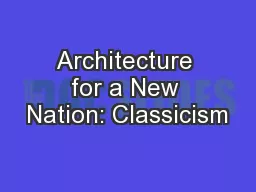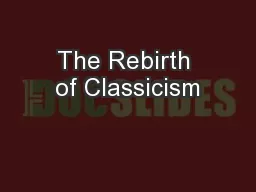PPT-Architecture for a New Nation: Classicism
Author : alexa-scheidler | Published Date : 2015-11-20
Why does it seem that every entrance to a building on the Mary Washington campus has a classical portico and at the campus center there is a bell tower taller than
Presentation Embed Code
Download Presentation
Download Presentation The PPT/PDF document "Architecture for a New Nation: Classicis..." is the property of its rightful owner. Permission is granted to download and print the materials on this website for personal, non-commercial use only, and to display it on your personal computer provided you do not modify the materials and that you retain all copyright notices contained in the materials. By downloading content from our website, you accept the terms of this agreement.
Architecture for a New Nation: Classicism: Transcript
Download Rules Of Document
"Architecture for a New Nation: Classicism"The content belongs to its owner. You may download and print it for personal use, without modification, and keep all copyright notices. By downloading, you agree to these terms.
Related Documents














